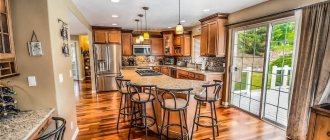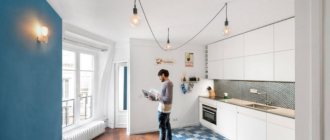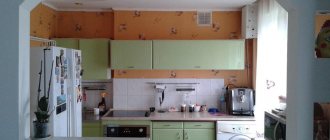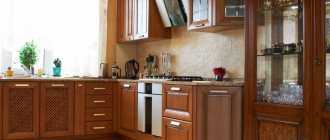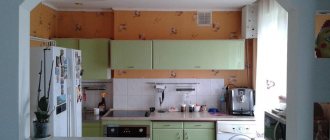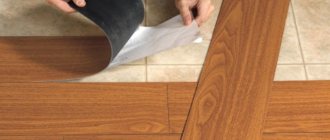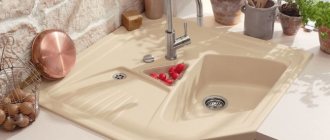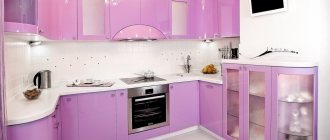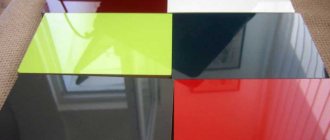The popularity of laminate flooring is growing every year. They began to actively lay it not only in living rooms, but also in the kitchen and bathroom. And if in the bathroom this type of flooring is still exotic, then in the room intended for cooking it is commonplace, replacing ceramic tiles and linoleum.
There are several reasons for dominance:
- the emergence of new types of lamellas that can withstand harsh operating conditions;
- beautiful appearance;
- the desire to make the same floors throughout the apartment;
- negative associations with linoleum left over from Soviet times;
- aggressive advertising of manufacturers and sellers of laminated panels.
There may be other, often individual reasons, which will certainly be given at the end of the work if readers share them.
The editors of the StroyGuru portal decided to delve into the problem more deeply and find out whether it is possible to lay laminate flooring in the kitchen of an apartment or house. During the analysis, we will find out where the real advantages of such a floor covering are, and where are the marketing moves of manufacturers, whether it is possible to find an alternative to laminate without losing quality and design, but saving money on materials and installation work.
Kitchen floor requirements
The kitchen is one of the rooms where, when choosing the type of flooring, the taste and preferences of the owner fade into the background. Here the priority indicators are:
- wear resistance - floors experience increased mechanical impact from the owners (studies by ergonomics experts show that residents spend about 40% of their time in the kitchen), as well as when moving stools and chairs from place to place;
- moisture resistance - the flooring is affected by two types of moisture: steam - in excess during cooking and water (more precisely, its splashes), which falls on the floor while working in the kitchen. Especially often the floor covering is wet in the work area;
The kitchen is in all its glory.
- easy care - stains from tea, coffee, wine, as well as grease should be easily washed off;
- durability - the service life of the floor covering is at least 25-30 years;
- safety - no one wants to get injured on a slippery floor;
- resistance to ultraviolet radiation and temperature changes.
And only after taking into account these criteria should you pay attention to the aesthetics of the material (appearance) and how it fits into the interior. If you ignore the above selection criteria, you can get a beautiful floor, which will soon become a headache for the owners.
Sound absorption
Living in apartment buildings forces people to look for ways to achieve maximum sound absorption.
- The Sound Protect layer, which gives the laminate a couple of extra mm, helps reduce noise levels.
- It is important to correctly lay an expensive board equipped with additional functions.
- To avoid any difficulties, it is better to watch a video about laminate installation in advance.
- The kitchen is a special place in any home, because delicious food is prepared here every day, and in the evening the whole family gathers for a cup of tea.
- To make your stay in such an important room as comfortable as possible, you should carefully select a good laminate.
It is important to take into account the absence of slipping, otherwise dangerous situations may occur. Moisture-resistant, durable material, selected according to all the rules, will delight the eye and wallet for a long time.
Is it possible to lay laminate flooring in the kitchen?
If we approach the problem purely formally, then yes, laminated panels can be installed in the kitchen. But their compliance with the above criteria will vary depending on the type of lamellas. This is best demonstrated by the pros and cons of laminate flooring in the kitchen.
Pros of the solution. Active promoters of laminate flooring in the kitchen give the following arguments:
- high strength of the floor - withstands mechanical loads well;
- long service life, which is difficult to agree with. Extreme operating conditions still take their toll. As a result, the manufacturer's stated warranty period is not met. Attempts to seek compensation from the companies that manufactured the slats are doomed to failure - the guarantee does not apply to floors in the kitchen and bathroom;
- good wear resistance - only applies to foot abrasion. Damage from falling sharp objects, animal claws, and furniture is common. After all, the protective film on the front side of the lamella is not hard enough and is easily scratched;
- simple care - what is common in other rooms of the apartment does not work in the kitchen - tea and coffee stains are difficult to remove;
- wide selection of designs: patterns, textures, colors and sizes. This is a top ten plus. Indeed, laminate can satisfy any consumer needs for any interior style. We must not forget that with the right color and size of the lamellas, you can visually change the dimensions of the room: length and width;
- relatively simple installation;
- can be placed on a “warm floor”;
- affordable price corresponding to the quality. And this is one of the myths of laminate flooring advocates in the kitchen. The statement about the best price-quality ratio does not stand up to criticism. The arguments are as follows:
- Cheap laminate from China will swell immediately after spilling moisture (water, juice, alcohol, tea, coffee). With intensive use (the kitchen is one such room), it wears out quickly and also releases harmful substances when heated.
- Average-priced laminate is good for residential premises, but not for the kitchen - it is afraid of water. All attempts to seal the joint between the lamellas with wax or silicone sealant are doomed to failure - over time, the grout joint becomes thinner and ceases to perform its intended functions. In addition, sealing is expensive.
- The laminate that manufacturers advertise as the best flooring option in the kitchen is more expensive than linoleum, tiles and some types of natural stone.
Conclusion: laminate in the kitchen is not the case when we can talk about an acceptable (affordable) price.
There are a couple more statements that do not correspond to the real state of affairs:
- absorbs noise coming from outside well - just the opposite: it amplifies sounds by resonating;
- retains heat - in fact, the thermal conductivity coefficient is high compared to linoleum and natural wood (only tiles and natural stone (marble, granite, etc.) are worse).
Manufacturers and sellers do not like to talk about shortcomings And they are significant:
- In the kitchen work area, only vinyl laminate can withstand - high humidity and grease do their job. But PVC laminate and classic slats are not the same thing;
- Any type of laminate contains formaldehyde resins, which when heated begin to release formaldehyde (HCHO). And the kitchen is famous for the fact that during cooking, both the temperature and humidity there fluctuate;
- the ability to amplify sounds (resonate) does not bring pleasure to both the neighbors below and the inhabitants of the apartment. Attempts to solve the problem with a thicker substrate lead to a more disastrous result - the locking joints quickly collapse;
- spilled grease and coffee are difficult to remove;
- smooth laminate is very slippery after wet cleaning, which manufacturers are silent about, but traumatologists know;
- Violation of installation technology can lead to deformation of the floor, followed by complete replacement of the floor covering.
Conclusion: the owner is a gentleman - he will arrange whatever he wants in the kitchen. But wisely, you need to look at alternative options, which we’ll talk about below.
In the meantime, for those who firmly believe in laminate in the kitchen, we’ll tell you how to choose it.
Selecting a coating based on wear resistance class
Laminate coatings are divided into 6 resistance classes and are marked with two numbers. The first means for which rooms the coating is intended, and the second means the degree of load: the higher the number, the greater the load the laminate can withstand. The following classes are intended for residential premises:
- 21 – for the bedroom and office;
- 22 – for the nursery and living room;
- 23 – for the kitchen, corridor, hallway.
Choosing a laminate
The higher the class, the more traffic it is designed for. For commercial premises, classes starting with 3 are intended:
- 31 – conference room, small office;
- 32 – office, boutique;
- 33 – gym, warehouse, restaurant.
For the kitchen and hallway, you can choose class 23 or 31. These coatings are designed for heavy loads, are resistant to abrasion, mechanical damage, and can withstand impacts.
How to choose laminate for the kitchen
When deciding which laminate to choose for the kitchen, you need to focus on the characteristics of the lamellas. First of all this:
- moisture resistance. Difficult operating conditions of the floor covering: high humidity and sometimes spilled water require the purchase of a moisture-resistant laminate. The fact that the product resists moisture is indicated by markings on the packaging in the form of a tap, a drop of water, the inscription “Aqua” or a drawn umbrella;
- wear resistance. Here you need to be especially careful. In popular literature, concepts are constantly being replaced: the strength class is attributed to the level of wear resistance. This kind of incident also occurs among professional craftsmen and experts. Therefore, you need to focus not on icon 33 or 34 (indicates the strength class), but on the combination of the letters AC and the numbers 3 or 4 or the number of people on the floor on the pictogram (see photo). For an apartment as a whole, abrasion class AC3 is sufficient, for the kitchen you need AC4 - too many people go there. And one more thing: wear resistance is not identical to the concept of hardness. This means that laminate flooring can withstand shuffling feet just fine, but suffer scratches or dents from pets' claws or falling breakable objects;
Abrasion class designations.
- strength. The criterion shows what dynamic and static load the slats can withstand during operation. That is, how much weight one panel can withstand over a long time. Let us be clear: you should not believe the numbers printed on the packaging. Reliable data is available only from products of German and Belgian companies. Although here, not everything is clear. Thus, the best models of class 32 have a higher level of strength than laminate in the class 34 segment, but with a more affordable price. One thing can be said about the products of Russian and Chinese enterprises - it’s a pig in a poke: you can buy both a good laminate and one with low strength characteristics. If we get lucky. For the kitchen, class 34 seems to be the best option - because of the refrigerator;
- surface type. The smooth surface of the laminate becomes slippery after wet cleaning. Therefore, it is better to buy textured slats. This is not only safety, but also a beautiful design, most often a wood look.
The cost of 1 m2 of laminate and its durability also play an important role. Although you don’t have to choose too much based on price: class 34 laminate with a high degree of wear resistance is correspondingly expensive (price starts from 2,500 rubles/m2).
Let's sum it up
So, the best laminate for the kitchen is moisture-resistant, class 33, with a non-slip surface with a slight texture. There is a higher wear resistance class - 34. This laminate is stronger, but it also costs significantly more. In our opinion, there is no point in overpaying.
Most modern options have a sound-absorbing layer 1-2 mm thick. If you don’t have it, buy a backing.
Click locks allow you to lay floors with base differences of up to 3 mm per linear meter. After installation, it is recommended to treat the panel joints with a special impregnation.
Don’t buy no-name laminate – don’t be fooled by the bargain price. If you are limited in finances, choose inexpensive coverage from a well-known brand, for example, Praktik or Decormatch. And look at the content of harmful substances, formaldehyde. Choose laminate marked E0 or E1 - it is safe for health.
For those who take into account the characteristics of the material, the coating will last a long time and retain its original appearance for the next ten years.
Is there a difference between moisture-resistant and water-resistant laminate and which is better?
The kitchen needs a floor that is not afraid of moisture. Manufacturers offer moisture-resistant slats. But waterproof laminate is sold along with them. Are these synonyms for the same type of flooring or something else? Let's figure it out.
On the one hand, purely logically there should be no difference between the concepts. After all, they give the same characteristic to materials - resistance to moisture. But manufacturers put into them completely different flooring characteristics.
So, by moisture-resistant we mean an MDF-based laminate, covered on the bottom with a film that does not allow water to pass through, and on the sides with wax. This protection allows you to protect floor panels from direct contact with water for ten minutes. After some time, water still begins to enter the body of the laminate. Absorption occurs at a level of 6-8%. But this is enough for the castles to swell and begin to collapse.
Moisture resistant laminate.
Waterproof slats absorb no more than 2% of water, while remaining completely immersed in water for up to a day. But such flooring is made from polyvinyl chloride and has nothing in common, except appearance, with classic laminate. It also has a different name: vinyl laminate.
By and large, this is the same linoleum, only cut into strips similar in size to laminate. By the way, PVC slats and linoleum have practically the same technical and operational characteristics, pros and cons. The differences are in price and complexity of installation - laminate is more difficult to install.
Conclusion: moisture-resistant and water-resistant laminate are completely different types of flooring. For the kitchen, with its humidity, you still need a waterproof product. But, according to the editors of the StroyGuru website, waterproof laminate for the kitchen is not quite the right solution.
After all, it is no different from linoleum in terms of technical characteristics and clearly loses in terms of the price factor. The problem is in the psychology of immigrants from the Soviet Union. They remember that nondescript floor covering with the beautiful name linoleum. And the fact that it has become completely different, fashionable in Western countries, is not yet perceived on a subconscious level.
Lamella structure
There are 2 types of waterproof laminate on the modern market.
- A matrix that is made using polymers.
- Composite laminate, which is created using pressed cellulose. Various polyurethane and polyethylene compounds are added to the latter.
The cheapest and most affordable laminate is considered to be the one made from polymer-wood composite materials. A similar line is created according to standards that allow it to resist liquid for 5 hours. Please note that such a coating has good thermal insulation. Among the disadvantages, one can point out the short matrix, which causes greater fragility during installation. To carry out installation, it is imperative to create a flat floor, as well as to ensure careful connection of the locks. Please note that such a product, in terms of technical parameters, is often compared to a decking board.
A cheaper waterproof laminate is considered to be one made using polymer-wood composite materials.
As for the polymer waterproof laminate, it is produced on the basis of polyvinyl chloride. Its shape is set using high pressure through special molds. Please note that the intermediate layer is made from polypropylene or polyethylene. The upper part is made using paper, PVC or other film. Products of this type have impressive strength. You can check by creating physical activity or changing temperature conditions.
Important! On such a floor you can not only use aggressive detergents, but also completely fill it with water for 20 hours.
moisture resistant laminate
Is it possible to make moisture resistant from ordinary laminate?
Apartment owners can, in order to save money, use ordinary slats to make a moisture-resistant laminate for the kitchen. This effect is achieved in several ways:
- cover the flooring with polyurethane varnish;
- treat the locks and bottom of each panel with polyurethane varnish or wax before installation;
- seal the seams with familiar silicone sealant;
- protect the locks from moisture by using wax grouts on the already laid laminate.
Such recommendations can be found literally on every corner: from manufacturers and sellers (well, of course, this is their bread that you want to eat with butter), professional builders (everything is also clear), numerous authors on various sites. To what extent the recommendations are correct (let’s be diplomatic and not use harsher statements), let’s find out.
1. Coating the floor with polyurethane varnish. There is no need to explain that the laminate is laid on a substrate. There is no other way. If there is a substrate, then there is vertical vibration of the lamellas under the weight of an adult when walking on the floor.
They are completely invisible to human eyes and legs. But the varnish layer reacts immediately to a deflection of one panel relative to another by only 0.5 mm - it loses its integrity. After a few months of use there will be no trace left of the protection. In addition, the varnish quickly wears off when walking and does not tolerate moving furniture - scratches immediately remain.
2. Treating the lock joints and the bottom of the panels with wax. Proponents of this method explain their proposal by the high porosity of the panel body. Firstly, this is not true - MDF, on the contrary, has a dense structure, and secondly, during operation, the locks of the laminate rub against each other, removing all types of protection. As a result, after a year or two, there will be no trace left of moisture resistance.
3. Silicone sealant. The elasticity of silicone allows you to maintain the integrity of the rubbed seam during vertical vibrations of the panels for a long time. But there is another problem: in work areas, the sealant is wiped off with feet within 4-5 months. Non-believer Thomas can look at the results of using a tiled floor, where epoxy grout, the most resistant, changes color and becomes gray in places with the greatest concentration of people.
This is not the result of exposure to UV rays, but the replacement of the epoxy layer with simple dust - when walking, the sealant clings to the sole with tiny particles. Dust settles in its place. As a result, the seams become depressurized. With silicone it’s even easier: it doesn’t have such strength.
4. Wax grouts. There's a lot of interesting stuff here. Not only does the cost of the floor increase (wax grouts are expensive - more than 25 rubles / m2), but the validity period is only a few months. Many will object: what is 25 rubles? even for families with below average income. But this is several times a year and for at least 10 years. The result is huge costs comparable to the cost of a new floor. So, is the game worth the candle?
Calculation of the required quantity
The amount of material required to cover the kitchen floor is determined based on its area, plus 5% for reserve.
If you install it yourself, you will need 12% more.
When laying strips diagonally, you need to buy 15% more than required for rectangular laying.
So maybe not laminate, but tiles
The forums are full of questions: which is better, laminate or tiles in the kitchen. But the question needs to be posed more broadly: what is the alternative to laminate in the kitchen. If you only consider the laminate/tile pair, then tiles have many advantages:
- does not scratch;
- not afraid of water and fat;
- easy to clean with any detergent;
- costs less than moisture-resistant slats;
- serves for a long time.
But it has one drawback: due to the hardness of the floor, the musculoskeletal system of a person who spends a lot of time in the kitchen - typical for mothers in large families - is heavily strained. This has already been discussed in one of the comments on our website.
Therefore, it is worth thinking about linoleum and quartz-vinyl laminate. They are affordable for home owners, are not afraid of moisture, look impressive, and are superior in quality to laminate. In some cases, even a specialist cannot visually distinguish linoleum from laminate.
What to prefer if you plan to have a heated floor
If we abstract from other performance characteristics of laminate and ceramic tiles, then any of the listed coatings can be placed on a “warm floor,” although with different effects.
Which mount is better
The coating created in the Lock format is noticeably inferior to its competitor in terms of external characteristics.
- Roughly speaking, it looks too cheap, and the locks are not extremely reliable.
- It is likely that the slabs will begin to diverge over time, and installation will require more effort.
- If you want to place laminate flooring on the wall in the kitchen, you should take a closer look at the Click coating.
- Of course, it requires a perfectly flat surface, but the result is simply phenomenal.
- Expensive decor made with such an elite laminate amazes the imagination, allowing you to surprise relatives and guests.
Thickness of the product: the thicker it is, the longer the laminate will last. Of course, as the volume of the board increases, its cost increases proportionately. If you carefully read the reviews of laminate buyers, it is the material with the maximum thickness that causes the greatest admiration.
Important: The minimum mark for the kitchen covering must be at least 9 mm.
Is it possible to combine tiles and laminate?
Practice shows that a combined tile and laminate floor in the kitchen is the most effective way to solve the problem of flooring in the busiest room of the apartment. In this case, the combination is always carried out according to the same scheme: the work area is tiles, the dining area is wear-resistant laminate.
This approach eliminates several problems:
- a safe sanitary area appears with a durable coating of tiles or porcelain stoneware, which is almost 2 times more wear-resistant than the best laminate;
- water leakage under the kitchen unit can be easily eliminated without consequences for the floor;
- the furniture and refrigerator sit on the tile like a glove - there is no play, like on laminate;
- There was an opportunity to lay ordinary (non-moisture resistant) laminate in another part of the kitchen, where there is no grease and water.
But such a floor covering has other design-related problems: how to choose the right laminate for the tiles in the kitchen so that the floor is a single whole and does not create the impression of an ever-drawn-out renovation.
How to arrange a transition
The combination of tiles and laminate requires solving the issue of transition from one type of floor to another. There are several ways to join floor coverings:
- using a cork gasket;
Cork gasket.
- covering the seam with an aluminum decorative strip used to fix linoleum near the walls;
Aluminum strip.
- sealing the seam with sealant;
- arranging a podium along the joint line;
- masking the connection of two types of flooring with a PVC overlay.
Vinyl overlay.
In this case, the connecting line should pass at a distance of one and a half steps of the cook (usually the mistress of the house) from the tabletop. This is a guarantee that when taking a step back, the cook will not trip over the threshold. The podium is set up in the same way. The tiles are 2-3 cm higher. Rarely, but it happens the other way around when the laminate is higher.
Attention: advice from the site staff - the seam line should not cross the main direction of movement of residents. Kitchen visitors should move parallel to the joint. In this case, the risk of tripping is zero.
Combination options
Both types of floors, regardless of the space occupied, color and texture, actively influence the perception of the interior. But there is a nuance: the floor covering adjacent to the furniture always more intensely shades and enhances the decorative effect of the furniture in the interior. Therefore, you need to pay special attention to the tiles and select them in contrast to the laminate or in similar color tones.
So, beige tile color goes well with brown or terracotta laminate. It does not draw attention to itself, but visually neutralizes high humidity and temperature in the kitchen, creates a calm, relaxing atmosphere, and has a calming effect on the nervous system.
The method of sealing seams should show kitchen visitors the floor as a single whole, although assembled from two different materials in color and texture.
Laminate laying technology
Laminate flooring is laid on both concrete floors and rough wooden floors. All work is performed in the following sequence:
- the base is being repaired;
- hydro- and thermal insulation work is being carried out;
- the screed is poured;
- A plastic film is laid over the screed;
- the substrate is laid;
- laminate is installed.
Laying laminate flooring is discussed in detail in the works: “How to lay laminate flooring on a concrete floor”, “How to properly lay laminate flooring on a wooden floor”.
